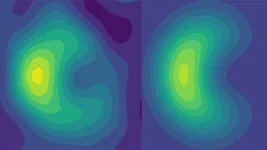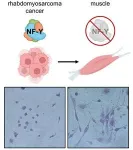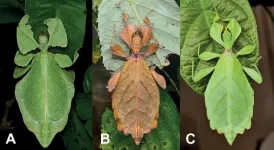(Press-News.org) DURHAM, N.C. – Researchers at Duke University have implemented a quantum-based method to observe a quantum effect in the way light-absorbing molecules interact with incoming photons. Known as a conical intersection, the effect puts limitations on the paths molecules can take to change between different configurations.
The observation method makes use of a quantum simulator, developed from research in quantum computing, and addresses a long-standing, fundamental question in chemistry critical to processes such as photosynthesis, vision and photocatalysis. It is also an example of how advances in quantum computing are being used to investigate fundamental science.
The results appear online August 28 in the journal Nature Chemistry.
“As soon as quantum chemists ran into these conical intersection phenomena, the mathematical theory said that there were certain molecular arrangements that could not be reached from one to the other,” said Kenneth Brown, the Michael J. Fitzpatrick Distinguished Professor of Engineering at Duke. “That constraint, called a geometric phase, isn’t impossible to measure, but nobody has been able to do it. Using a quantum simulator gave us a way to see it in its natural quantum existence.”
Conical intersections can be visualized as a mountain peak touching the tip of its reflection coming from above and govern the motion of electrons between energy states. The bottom half of the conical intersection represents the energy states and physical locations of an unexcited molecule in its ground state. The top half represents the same molecule but with its electrons excited, having absorbed energy from an incoming light particle.
The molecule can’t stay in the top state — its electrons are out of position relative to their host atoms. To return to the more favorable lower energy state, the molecule’s atoms begin rearranging themselves to meet the electrons. The point where the two mountains meet —the conical intersection — represents an inflection point. The atoms can either fail to get to the other side by readjusting to their original state, dumping excess energy in the molecules around them in the process, or they can successfully make the switch.
Because the atoms and electrons are moving so fast, however, they exhibit quantum effects. Rather than being in any one shape — at any one place on the mountain — at any given time, the molecule is actually in many shapes at once. One could think of all these possible locations as being represented by a blanket wrapped around a portion of the mountainous landscape.
But due to a mathematical quirk in the system that emerges from the underlying mathematics, called a geometric phase, certain molecular transformations can’t happen. The blanket can’t wrap entirely around the mountain.
“If a molecule has two different paths to take to get to the same final shape, and those paths happen to surround a conical intersection, then the molecule wouldn’t be able to take that shape,” said Jacob Whitlow, a doctoral student working in Brown’s laboratory. “It’s an effect that’s hard to gain intuition for, because geometric phase is weird even from a quantum mechanical standpoint.”
Measuring this quantum effect has always been challenging because it is both short-lived, on the order of femtoseconds, and small, on the scale of atoms. And any disruption to the system will prevent its measurement. While many smaller pieces of the larger conical intersection phenomenon have been studied and measured, the geometric phase has always eluded researchers.
“If conical intersections exist — which they do — then the geometric phase has to exist,” said Brown, who also holds appointments in Duke physics and chemistry. “But what does it mean to say something exists that you can’t measure?”
In the paper, Whitlow and coworkers used a five-ion quantum computer built by the group of Jungsang Kim, the Schiciano Family Distinguished Professor of Electrical and Computer Engineering at Duke. The quantum computer uses lasers to manipulate charged atoms in a vacuum, providing a high level of control. Whitlow and Zhubing Jia, a PhD student in Brown’s laboratory, also expanded the capability of the system by developing ways to physically nudge the floating ions within their electromagnetic traps.
Based on how the ions are moved and the quantum state that they’re placed in, they can fundamentally exhibit the exact same quantum mechanisms as the motion of atoms around a conical intersection. And because the quantum dynamics of the trapped ions are about a billion times slower than those of a molecule, the researchers were able to make direct measurements of the geometric phase in action.
The results look something like a two-dimensional crescent moon. As depicted in the conical intersection graph, certain configurations on one side of the cone fail to reach the other side of the cone even though there is no energy barrier. The experiment, Brown says, is an elegant example of how even today’s rudimentary quantum computers can model and reveal the inner quantum workings of complex quantum systems.
“The beauty of trapped ions is that they get rid of the complicated environment and make the system clean enough to make these measurements,” said Brown.
An independent experiment at the University of Sydney, Australia has also observed the effects of the geometric phase using an ion trap quantum simulator. The approach differs in many technical details, but the overall observations are consistent. The Sydney work will be published in the same issue of Nature Chemistry.
This work was supported by Intelligence Advanced Research Projects Activity (W911NF-16-1-0082), the National Science Foundation (Phy-1818914, OMA-2120757), the Department of Energy Office of Advanced Scientific Computing Research QSCOUT program (DE-0019449), and the Army Research Office (W911NF-18-1-0218).
CITATION: “Simulating Conical Intersections with Trapped Ions,” Jacob Whitlow, Zhubing Jia, Ye Wang, Chao Fang, Jungsang Kim, and Kenneth R. Brown. Nature Chemistry, August 28, 2023. DOI: 10.1038/s41557-023-01303-0
# # #
END
Quantum computer unveils atomic dynamics of light-sensitive molecules
A quantum computer slowed simulated molecular quantum effects by a billion times, allowing researchers to directly measure them for the first time
2023-08-28
ELSE PRESS RELEASES FROM THIS DATE:
Enter Sandman: Study shows dreams spill over into the workplace and can be channeled for productivity
2023-08-28
Before heading to work each day, most people have spent the night dreaming. Studies show that on any given morning, about 40 percent of the working population recalls their dreams.
New research from the University of Notre Dame shows that when dreams are first recalled, people often draw connections between their dreams and waking lives, and the connections they draw alter how they think, feel and act at work.
“A Spillover Model of Dreams and Work Behavior: How Dream Meaning Ascription Promotes Awe and Employee Resilience” is forthcoming in the Academy of Management Journal from lead author Casher Belinda, assistant professor ...
Gender disparities limit chances for women PhD students training to be new inventors
2023-08-28
In the innovation economy, individuals with STEM PhDs are a critical source of human capital, with nearly 60 percent of PhDs in STEM fields— such as engineering, chemistry and biology—being employed outside of universities. These students are increasingly contributing to commercial science through patenting. New research from MIT Sloan School of Management and Copenhagen Business School investigated the training of these PhD students to better understand the pipeline and preparation of new inventors.
Conducted by Fiona Murray, MIT Sloan professor and associate dean for Innovation and Inclusion, ...
New startups join Argonne’s entrepreneurship program
2023-08-28
Four new innovators recently joined Chain Reaction Innovations (CRI), the Lab-Embedded Entrepreneurship Program at the U.S. Department of Energy’s (DOE’s) Argonne National Laboratory, as part of the program’s seventh cohort.
Each innovator will collaborate with a host scientist at Argonne while embedded full-time at the laboratory. Innovators plan to develop clean energy startups that reduce greenhouse gas emissions and increase U.S. competitiveness in emerging energy technologies. The ...
Curious and cryptic: new leaf insects discovered
2023-08-28
An international research team including the University of Göttingen has described seven previously unknown species of leaf insects, also known as walking leaves. The insects belong to the stick and leaf insect order, which are known for their unusual appearance: they look confusingly similar to parts of plants such as twigs, bark or – in the case of leaf insects – leaves. This sophisticated camouflage provides excellent protection from predators as well as presenting a challenge to researchers. Genetic analysis enabled the researchers to discover “cryptic species”, which cannot be distinguished by their external appearance alone. The findings are not only ...
Preparing clinicians for the international anti-LGBTQI+ crisis
2023-08-28
Contact: Maria Ober, 617-224-8963, mpober@bu.edu
Preparing Clinicians for the International Anti-LGBTQI+ Crisis
Medical community should build systems that are responsive to this population
(Boston)—Lesbian, gay, bisexual, transgender, queer, intersex and additional sexual and gender minority (LGBTQI+) people in every region of the world face marginalization and oppression. At least 67 countries ban sexual conduct between consenting adults of the same sex. According to a report from the ...
PSA levels after treatment may not be reliable predictor of survival for patients with prostate cancer
2023-08-28
FINDINGS
A UCLA-led study found treatments that reduce the risk of being diagnosed with a cancer recurrence based on rising prostate-specific antigen (PSA) levels after radiotherapy, commonly referred to as biochemical recurrence, do not necessarily improve a patient’s long-term overall survival.
The team of investigators found that while biochemical recurrence was associated with a higher risk of death, it still did not meet the criteria to be a reliable surrogate endpoint for overall survival. As defined by the FDA, a clinical outcome directly measures whether people in a trial feel or function better, or live ...
Two networks, two realities, one big problem
2023-08-28
National news coverage from the two largest broadcast outlets, CNN and Fox News, not only reflects growing political polarization in America, but in a recent publication, researchers at Virginia Tech have shown that partisan and inflammatory broadcast coverage has increased over time and can exacerbate growing divides in the new public square of social media.
Collaborative insights
Eugenia Rho is assistant professor in the Department of Computer Science with a background in political science and a passion for ...
The physics of fat droplets reveal DNA danger
2023-08-28
Fat is a normal and necessary part of the body. Fat cells store and release energy, as well as play significant roles in hormonal regulation and immunity.
In recent decades, a concerning rise in metabolic illnesses – such as cardiovascular disease, high blood pressure and diabetes – has focused scientific attention on the biology and chemistry of fat, resulting in a wealth of information about how fat cells work.
But fat cells and their metabolic activities are only part of the story.
Fat-filled lipid droplets, tiny spheres ...
SfN’s TPDA Program earns ASAE 2023 Power of Associations Gold Award
2023-08-28
WASHINGTON, D.C. – The Society for Neuroscience (SfN) earned a Power of Associations Gold Award from the American Society of Association Executives (ASAE) for its successful Trainee Professional Development Award (TPDA) program. ASAE’s Power of Association awards celebrate and promote the invaluable contributions that associations make within the U.S. and globally through catalytic initiatives focused on professional advancement, global development, diversity and inclusion practices, advocacy, and community support and engagement.
In operation since 2015, the TPDA program recognizes undergraduate and graduate ...
New approach to fighting malaria
2023-08-28
RIVERSIDE, Calif. -- The mosquito-borne infectious disease malaria resulted in about 241 million clinical episodes and 627,000 deaths in 2020. In young children and pregnant women living in areas where the disease is endemic, a major cause of death is Plasmodium falciparum, the most virulent, prevalent, and deadly human malaria parasite.
Scientists are keen to understand the mechanisms that regulate gene expression through the different stages of P. falciparum’s lifecycle because such knowledge can ...
LAST 30 PRESS RELEASES:
Johns Hopkins-led team creates first map of nerve circuitry in bone, identifies key signals for bone repair
UC Irvine astronomers spot largest known stream of super-heated gas in the universe
Research shows how immune system reacts to pig kidney transplants in living patients
Dark stars could help solve three pressing puzzles of the high-redshift universe
Manganese gets its moment as a potential fuel cell catalyst
“Gifted word learner” dogs can pick up new words by overhearing their owners’ talk
More data, more sharing can help avoid misinterpreting “smoking gun” signals in topological physics
An illegal fentanyl supply shock may have contributed to a dramatic decline in deaths
Some dogs can learn new words by eavesdropping on their owners
Scientists trace facial gestures back to their source. before a smile appears, the brain has already decided
Is “Smoking Gun” evidence enough to prove scientific discovery?
Scientists find microbes enhance the benefits of trees by removing greenhouse gases
KAIST-Yonsei team identifies origin cells for malignant brain tumor common in young adults
Team discovers unexpected oscillation states in magnetic vortices
How the brain creates facial expressions
Researchers observe gas outflow driven by a jet from an active galactic nucleus
Pitt student finds familiar structure just 2 billion years after the Big Bang
Evidence of cross-regional marine plastic pollution in green sea turtles
Patients with clonal hematopoiesis have increased heart disease risk following cancer treatment
Stem cell therapy for stroke shows how cells find their way in the brain
Environment: Up to 4,700 tonnes of litter flows down the Rhine each year
Maternal vaccine receipt and infant hospital and emergency visits for influenza and pertussis
Interim safety of RSVpreF vaccination during pregnancy
Stem cell engineering breakthrough paves way for next-generation living drugs
California grants $7.4 million to advance gene-edited stem cell therapy for Friedreich’s ataxia
Victoria’s Secret grant backs cutting-edge ovarian cancer research
Research paves the way for safer colonoscopy bowel prep for people with compromised gut health
JMIR Publications and Sweden's National Library announce renewal and expansion of flat-fee unlimited open access partnership for 2026
A new 3D-printed solar cell that’s transparent and color-tunable
IV iron is the cost-effective treatment for women with iron deficiency anemia and heavy menstrual bleeding
[Press-News.org] Quantum computer unveils atomic dynamics of light-sensitive moleculesA quantum computer slowed simulated molecular quantum effects by a billion times, allowing researchers to directly measure them for the first time





